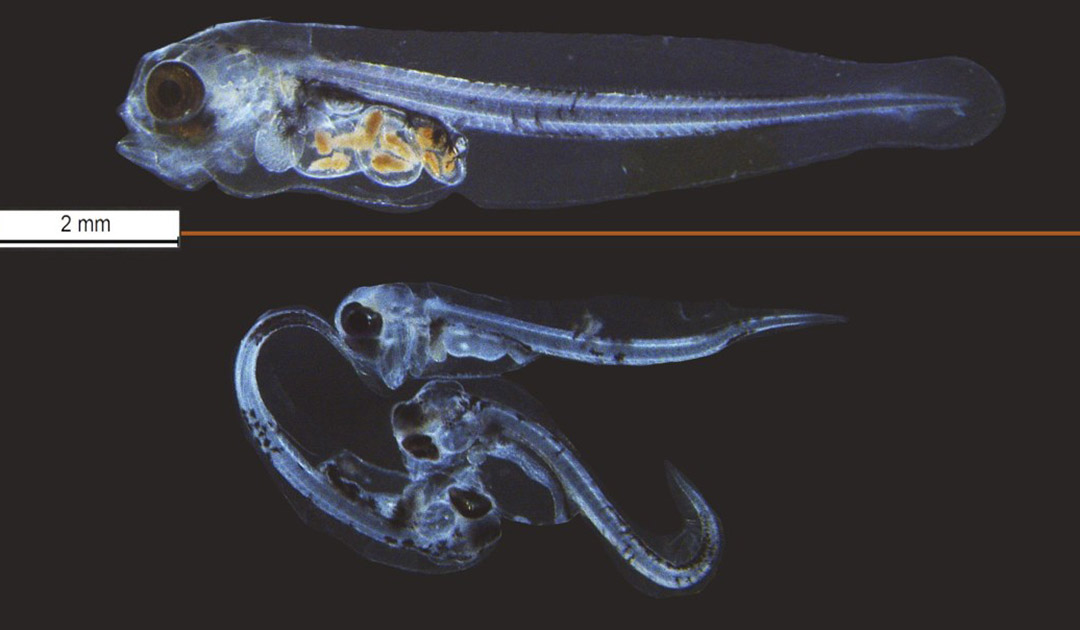
Polar cod are the central component in the Arctic marine food web. Marine mammals, seabirds and other fish species feed partly exclusively on the small fish, which represent the most important link in the energy flow between plankton organisms and ice-associated vertebrates. Climate change is already affecting this important Arctic fish species, as its development is closely linked to sea ice. Further negative effects on this key species, for example through pollution, would most likely have devastating consequences for the Arctic food web. In a recent study, scientists from the Arctic University of Norway therefore investigated the effects of oil pollution on the animals.
Rising temperatures in the Arctic are opening up more and more opportunities for shipping and mineral exploration, which also increases the risk of oil spills. In the Arctic, containing and cleaning up oil spills would be even more difficult than in other parts of the world. For example, when oil comes into contact with sea ice, it cannot be removed and is released in small quantities over long periods of time through melting processes. Even if a disaster does not occur, small oil spills from industrial activities are virtually impossible to rule out.
The research project of Morgan Lizabeth Bender, a PhD student at the Arctic University of Norway, and her colleagues targeted precisely these small pollutions. They chose the polar cod for their study because it plays a special role in the Arctic ecosystem. The scientists were able to show that smallest amounts of crude oil are sufficient to cause damage to polar cod embryos and juveniles, especially in combination with warmer water.
During a research trip in the Barents Sea, the researchers caught adult polar cod, which were cared for in a research station near Tromsø. After laying their eggs in winter, the experiment began. Bender and her team recreated different scenarios in several aquariums:
- Different degrees of oil contamination as well as pure water at 0.5°C water temperature
- Different degrees of oil pollution as well as pure water at 2.8°C water temperature (to imitate climate change-induced temperature increase)

In the experiment, however, the researchers did not introduce the crude oil directly into the aquariums. Instead, it was bound to gravel that was in contact with the system outside the tanks, simulating the release of oil from melting sea ice. The amount of crude oil the embryos and fry were exposed to was very small, with levels ranging from 0.19 grams to 3 grams of oil per kilogram of gravel, which Bender says is equivalent to about five drops of oil in an Olympic-sized swimming pool. They were interested in seeing how the fish reacted to diluted oil and residues of soluble components in the water. Bender assumes that at very low levels of oil pollution, the water-soluble fraction will be most relevant in the Arctic.
Over 56 days, the scientists observed the development of the polar cod from the time of fertilization until the hatching of the young fish, which later began to feed. The first finding was that the larvae in the warmer water hatched over two weeks earlier than those in the colder water. The larvae showed no significant differences immediately after hatching, regardless of the conditions under which they developed.
It wasn’t until the fish began to take shape that the researchers saw that malformations were occurring, especially on the jaw. The young fish that were exposed to both warmer water and oil were the most likely to develop abnormalities. The higher the oil concentration, the more common the malformations were in the fish. Nearly one hundred percent of the fish exposed to the highest concentration of oil had deformed jaws. In addition, all juvenile fish lost the ability to absorb nutrients under these conditions.

The research team discovered further anomalies when examining the heart rate of the newly hatched juvenile fish. At higher temperatures and increasing oil concentrations, the heart rate decreased and cardiac arrhythmias occurred more frequently. Mortality was also increased under these conditions.
“The absolute highest mortality was among fry that experienced both a climate change situation and oil. We call this a synergistic effect. This means that the effect of temperature and oil was much greater when they co-occurred,” says Bender.
After the nutrients from the yolk sac were used up and the fry began feeding independently, only eight percent of the animals survived in polluted warmer water and 23 percent in polluted cold water.
According to Bender, the study shows that the polar cod is a very sensitive species that seems to be vulnerable to even very small amounts of oil.
Sonnich Meier, a researcher at the Norwegian Institute of Marine Research, reviewed the study and notes the importance of examining the effects of multiple stressors simultaneously. For example, it was shown that warmer water can exacerbate the harmful effects of oil exposure.
The Norwegian Institute of Marine Research has received funding in late 2020 for a project to model the effects of an oil spill near the ice edge on key species such as polar cod.
According to the Environmental Monitoring of Svalbard and Jan Mayen, the stocks of polar cod have been declining since 2010. This is despite the fact that the species is of no importance to the fishery. The rise in temperature may be responsible.
Julia Hager, PolarJournal
More on the subject:





